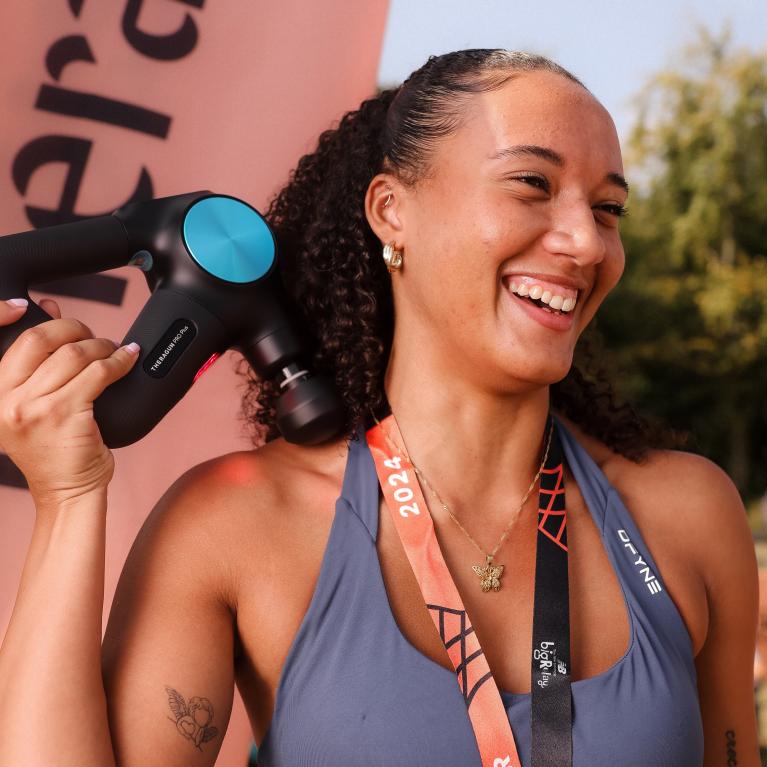Why recovery is the real key to strength: Dr. Jason Wersland’s five-step guide

“We don't get stronger in the gym or when we're running. We get stronger when we recover.”
Anyone who follows Therabody founder Dr Jason Wersland on Instagram will be familiar with his mantra. He says we often associate strength gains with time spent training, but true progress happens during recovery as rest is essential for muscle growth and injury prevention.
So that you can train smarter and perform better, Dr. J shares five practical steps to make recovery part of your routine.
Sponsored by Therabody
1. Recovery should happen daily
Recovery should be part of your daily routine, not something you will ‘get around to’ later in the week.
“If you run in the morning, you should do something [recovery] in the evening,” says Dr. J. “You can stretch, you can use your Theragun. Just don’t wait too long or you’re already behind.”
Exercise causes microtears in your muscles and over time these will heal, and your muscles will grow bigger and stronger. However, this occurs during rest and recovery. Training constantly without recovery will lead to shortened muscles, increased pressure on your joints and, ultimately, injury or compromised performance.
Try ‘habit stacking’ your recovery; find moments where you can add it to your existing routine. For example, before you brush your teeth or 10 minutes before you go to bed. This will help you make it part of your day.
Dr. J recommends starting with the Therabody app to get the most out of your Therabody products, including the Theragun. The free app offers guided routines and recommendations to help you maximize recovery and performance.
2. Don’t ignore the warning signs
Dr. J says you should listen if your body is trying to tell you something.
“Take a moment to localise the issue in your body, connect with it, and understand how to flush it out,” he explains.
“Our body has warning signs, just like a car, and sometimes we ignore them, because it's not that bad, or if it's still an issue next Tuesday, you’ll call the doctor then.”
He also says context will help you figure out what could be going on with your body.
For example, if your feet are hurting after training. “It's the ability to recognise why are they hurting so badly? Did I change my shoes recently? Did I do something different in my plan?”
3. Regulate your nervous system
We operate in two primary nervous system states: “fight-or-flight”, driven by the sympathetic nervous system, and “rest-and-digest”, governed by the parasympathetic nervous system. Recovery happens in the latter.
If your mind is constantly racing, your heart rate is elevated and your blood pressure is high, it’s a sign you’re stuck in stress mode. To support recovery, you need to shift to your rest-and-digest state – through practices that calm the mind and body, such as breathwork, stretching, or using recovery tools such as the Theragun.
Using a Theragun for just two minutes or more can activate your parasympathetic nervous system – this helps slow your heart rate, lower blood pressure, and promote a deep sense of relaxation.
If you’re looking for other practices during your day to activate your parasympathetic nervous system, it could also be the perfect time to try these breathwork exercises listed on the Therabody site.
4. Consider how your training is impacting your life
Mental recovery is just as important as physical recovery for runners during training, says Dr. J. In the lead up to Event Day, you’re following your Training Plan, perhaps you’ve joined a run club, or you’ve started a new strength and conditioning class. Be conscious of these new commitments, and don’t forget to be kind to yourself.
Using a Theragun daily may help enhance your resilience by improving heart rate variability (HRV) – a key indicator of your body's ability to shift between stress and recovery. Higher HRV reflects a more balanced nervous system and better overall recovery, signalling that your body is adapting well to physical and mental demands.
“Tools like massaged guns can help runners relax and recover,” says Dr. J.
A study we conducted showed that a daily six-minute Theragun treatment for five weeks increased HRV levels, a marker of how your body responds to stress, by 25%.”
5. Don’t skimp on sleep
A lack of sleep will hold you back and it’s important you’re getting enough each night and not trying to play catch-up on the weekend.
Sleep is your body's chance to repair and create new muscle. It also boosts your immune system and regulates your hormones, and lowers cortisol, a stress hormone that can hinder muscle recovery.